
Massachusetts Institute of Technology (MIT) scientists have developed a new system that can convert carbon dioxide and other greenhouse gases into useful fuel for cars and aircraft.
The researchers used a membrane - made of lanthanum, calcium, and iron oxide. It allows the oxygen from carbon dioxide to migrate through the membrane to the other side, leaving carbon monoxide behind.
Carbon monoxide produced during this process can be used as a fuel by itself or combined with hydrogen and/or water to make many other liquid hydrocarbon fuels.
It can also be used to produce methanol (used as an automotive fuel), syngas, and so on.
This new process could become part of the carbon capture, utilisation and storage (CCUS) technologies which, if applied to electricity production, could reduce the impact of fossil fuel use on global warming.
The membrane is "100 percent selective for oxygen," allowing only those atoms to pass.
The researchers used a stream of fuel such as hydrogen or methane which get readily oxidised and draw the oxygen atoms through the membrane.
The membrane also prevents the oxygen from migrating back and recombining with the carbon monoxide, to form carbon dioxide all over again.
The method may not only cut greenhouse emissions; it could also produce another potential revenue stream to help defray its costs, researchers indicated.